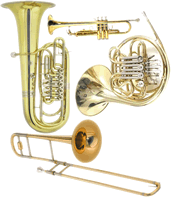 Performance Techniques (cont.) Performance Techniques (cont.)
Rhythmic Accents
While
are commonly played by brass instruments, the dramatic quality of the
brass section is also in evidence when playing rhythmic accents. The sharp
bite of metallic sound that can be produced by the brass add powerful
emphasis to any rhythm. Listen to the effect it creates:

While this musical example is made up of
rhythms, the effect would be just as dramatic if the parts were simply
played on a downbeat.
Melodic Qualities
We've spent most of this discussion concentrating on
the dramatic effects of brass instruments. But the brass can also play
soothing, legato passages. Like the strings, the brass are capable of
creating smooth velvety tones - perfect for background harmonies and soft
textures. In this next example, the brass sounds anything but dramatic:

Of course the brass can also play melodies. The distinct
voices of each of the brass instruments are explored further in their
individual chapters. Their special effects are also discussed in those
chapters as well.
Mutes
While all brass instruments can use mutes, the discussion
of each of the individual mutes can be found in the Trumpet chapter, as
the trumpet is the brass instrument
whose muted sounds we are most familiar with.
|